
Between the towns of Guijo de Granadilla and Oliva de Plasencia a group of ruins are scattered among cork oaks and holm oaks. A square shape stands out among the foundations and column bases. A four-sided arch which stands as a spectrum of what was once a living population. Today, there is nothing left but stones from the disappeared city that was called Capera, part of the province of Lusitania. The current remains are called Cáparra and are in Cáceres.

Roman Arco de Cáparra. | Depostiphotos
This is how Cáparra was during a large part of the Roman Empire. However, its history goes back to more ancient times. It is believed to have been a Veton site, belonging to this pre-Roman culture of Celtic origin. The place name Capera and its derivatives like the present one come from this past. During the first stages as a city attached to Rome it was stipendary. This means that it maintained a certain independence in exchange for giving tribute and participating in the dynamics of the army.

Aerial view of Cáparra. | Shutterstock
The passage of the Vía de la Plata, which connected modern-day Astorga and Mérida, meant that it was quickly Romanised. In addition, the benefits of trade were extensive. Its great moment came as a result of a law passed in 74 AD, when Vespasian promulgated the Edict of Latinity. As a result, the provinces of Hispania came under the Ius Latii or Latin Law. This meant that its inhabitants were granted citizenship. To do so, they had to join a Roman tribe, the one chosen by the emperor being the Quirina. Thus, Cáparra became a Municipium.
The development was made around two main streets, the cardus and the decumanus. The Via de la Plata coincides with the latter. At the crossroads was the Arco de Cáparra, which will be described later. Baths, forum and domus complexes, large Roman houses that sometimes had separate spaces for shops that were built on their ground floor. A wall of a more symbolic than defensive nature surrounded the city, in which the Veton past could be seen through details relating to temples or in the names of the inhabitants.
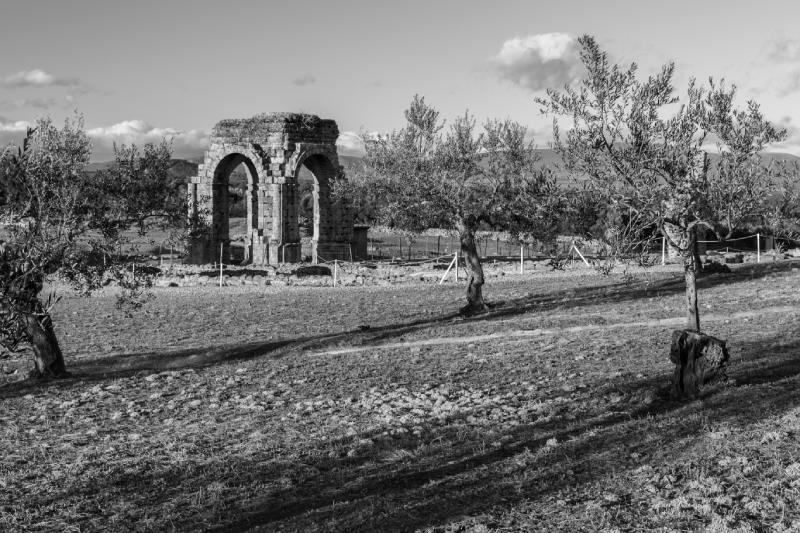
Arco de Cáparra. | Depositphotos
At the end of the first century of this era, the Arco de Cáparra was raised, reaching 13 metres in origin. Almost square, it is the only example of a four-sided arch that survives in Spain. This type of building is known as tetrapylum. An inscription on it tells us who commissioned it. It was Marcus Fidius Macer and he did so following the bequest of his parents, Fidius Macer and Bolosea, who are also named.
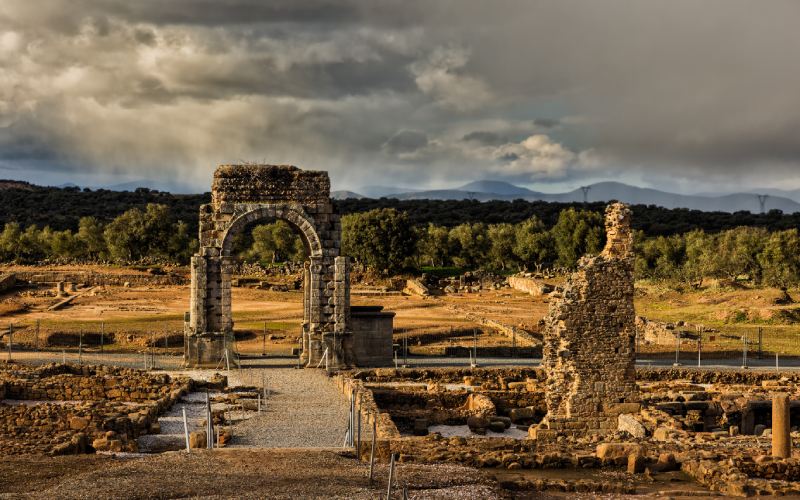
Arch and thermal baths of Cáparra. | Shutterstock
It is the best preserved monument in the Roman city of Cáparra. However, another one, corresponding to one of the gates, survived until the end of the 18th century. Unfortunately, the inhabitants of Guijo de Granadilla dismantled it in order to use its stones to build a small temple. Its figure defines the landscape of the surrounding pastures. On one of its sides there are two pedestals that once supported two sculptures. It is believed that they were probably related to Marcus Fidius Macer.
The particularity of the Arco de Cáparra has meant that it has become a current symbol for the road that crossed it. Over the last few decades the Via de la Plata has been recovered as a cultural route. Its branches extended beyond Mérida and Astorga in Roman times, reaching Cádiz, for example, through the Via Augusta. Such an extensive route was used even before the Romans, for example by the Carthaginians and the Celtiberians. However, when it became a road, it became the junction that connected the north and the south of the peninsula.
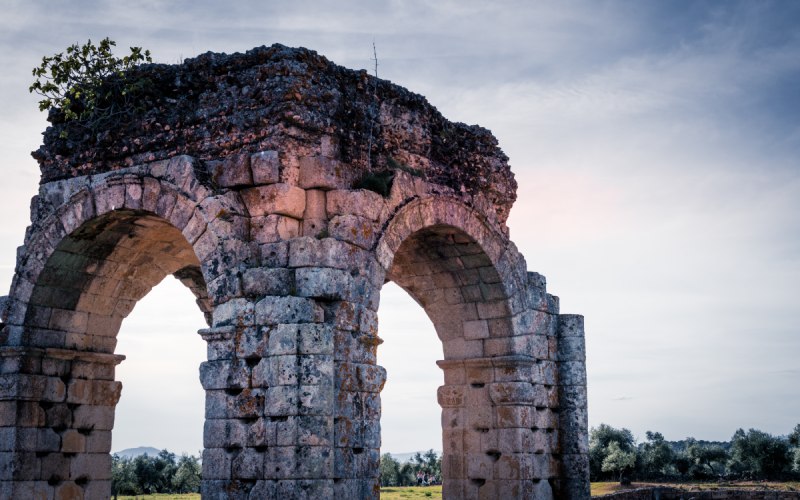
Arco de Cáparra. | Shutterstock
The Way to Santiago took advantage of its communicative capacity and was the favourite route from the south. Today, it gathers pilgrims from Seville and Huelva. It advances to Aldeanueva del Camino and the thermal waters of Baños de Montemayor in the vicinity of Bejar. Among its ends is the Sanabria route, which goes through Puebla once it passes Zamora. In Extremadura, the milestones which follow this ancient road use the Arco de Cáparra as an identifying element. For this reason, the passage under it is a very evocative moment, in one of the hardest stages of the route, almost 40 kilometres without hardly any stops.
The city evolved and came to have an amphitheatre on its outskirts, even a reservoir. During the crisis of the 3rd century, when instability caused the Roman Empire to tremble, it erected some walls and many of its domus became residential blocks. However, it managed to hold its own during this period. The transition to the Middle Ages, however, was more problematic. As an enclave that lived off trade and agriculture, the barbarian invasions led to its rapid decline.
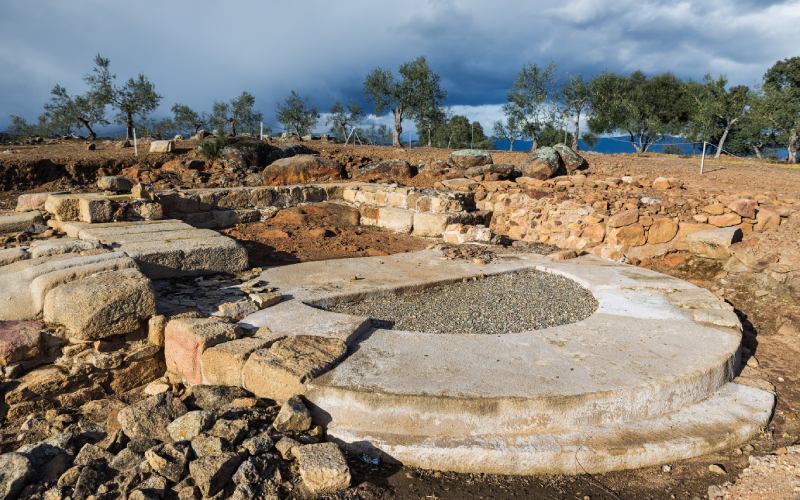
Base of a bastion next to one of the gates of Cáparra. | Shutterstock
There are no records that mention it during the Arab conquest of the peninsula. This suggests that by then it was little more than a village. Some experts suggest that it was completely abandoned. Experts such as Enrique Cerrillo point out that small neighbourhood communities survived in what was once a city for centuries. The foundation of towns such as Plasencia condemned the old population to not be reborn. Their land was divided between this town and Coria.

Thermal Baths of Cáparra. | Shutterstock
Already in the Modern Age there are testimonies that place in it a sale with several inns. The displacement of the communication routes outside Cáparra meant that even these disappeared. Therefore, the depopulation ended up being total. The ruins were damaged over the years and the deterioration was absolute. To make matters worse, as mentioned above, the arch of one of the gates was destroyed in 1728 to make use of the resulting materials.
Archaeological and cultural interest in Cáparra is not new. Since the Renaissance this Roman legacy has been valued. Illustrated and Romantic people paid their attention to the place. However, the main works were carried out in 1929, at the end of the eighties and beginning of the 21st century. They are still active. It also has an interesting visitors’ centre that serves as a stopping point for some pilgrims on the Way to Santiago, sometimes even at night. It is open every day except Monday and Sunday afternoons.
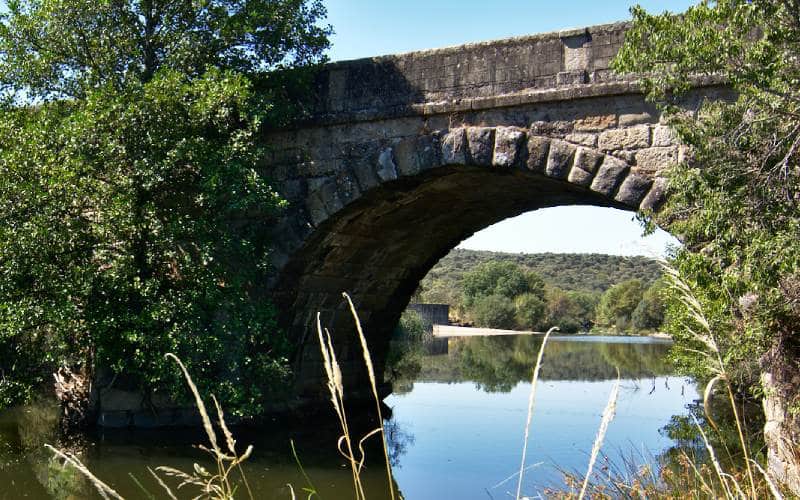
Roman bridge of Cáparra. | Wikimedia
The thermal baths are the best preserved remains apart from the Arco de Cáparra. It is complemented by the remains of the forum, the domus and two of the three main gates of the city. Near the urban area, there is the bridge of Cáparra over the Ambroz River. This waterway fed the city and its surroundings. Its two main arches are confirmed as Roman and are in a great state of conservation. However, the adaptation and widening to allow a national road to pass through it meant that it was flattened and much of its original appearance was lost.
Surrounding the lost city of Cáparra are meadows of extraordinary beauty. The one in Casablanca offers routes, for example. Furthermore, between Venta Quemada, six kilometres away, and Carcaboso there is a signposted path, part of the Jacobean route. This way you can travel freely. Another walk of about seven kilometres connects with Oliva de Plasencia and passes through the grounds of the Antonio López Gibaja cattle farm. Wide barriers make this route safe, which pilgrims use to reach the ruins from the aforementioned village in Extremadura if they decide to spend the night there.